Peisistratos
Peisistratos (Greek: Πεισίστρατος; died 528/7 BC), latinised Pisistratus, the son of Hippocrates, was a ruler of ancient Athens during most of the period between 561 and 527 BC.[1] His legacy lies primarily in his instituting the Panathenaic Games, historically assigned the date of 566 BC, and the consequent first attempt at producing a definitive version of the Homeric epics. Peisistratos' championing of the lower class of Athens, the Hyperakrioi (see below), is an early example of populism. While in power, Peisistratos did not hesitate to confront the aristocracy, and he greatly reduced their privileges, confiscated their lands and gave them to the poor and funded many religious and artistic programs.[2] He did so with the goal of improving the economy and spreading the wealth more equally among the Athenians.
Peisistratos | |
|---|---|
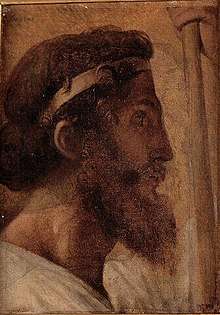 19-century depiction | |
| Tyrant of Athens | |
| Assumed office 561 BC, 559-556 BC, 545-528 BC | |
| Personal details | |
| Born | 608 BC Athens, Greece |
| Died | 528/7 BC Athens, Greece |
Peisistratus was a one-time brother-in-law of Cleisthenes;[3] however, Peisistratus was much older.
Peisistratids is the common term for the three tyrants who ruled in Athens from 546 to 510 BC, namely Peisistratos and his two sons, Hipparchus and Hippias.
Rise
Peisistratos was a distant relative of Solon from northern Attica. He had made a name for himself by capturing the port of Nisaea in nearby Megara by creating a successful coup in 565 BC.[4] Peisistratos was backed by the Men of the Hill, the poorer and majority of the population. This victory opened up the unofficial trade blockage that had been contributing to food shortages in Athens during the previous several decades.[5]
In the period after the Megaran defeat, several political factions competed for control in the government of Athens. These groups were both economically and geographically partitioned.[6]
- Pedieis: the population that resided on the plains, led by Lycurgus. These landowners produced grain, giving them leverage during the food shortage.
- Paralioi: the population living along the coast, led by Megacles, an Alcmaeonid, the Paralioi party was not as strong as the Pedieis, primarily because they could not produce grain, as did the plainsmen. With the Megareans patrolling the sea, much of Athens' import/export power was limited.
- Hyperakrioi: not previously represented by formal party, dwelled primarily in the hills and were by far the poorest of the Athenian population. Their only production was barter in items like honey and wool. Peisistratos organised them into the Hyperakrioi, or hill dwellers. This party grossly outnumbered the other two parties combined.
His role in the Megarian conflict gained Peisistratos popularity in Athens, but he did not have the political clout to seize power. Herodotus tells us how he intentionally wounded himself and his mules in order to demand from the Athenian people bodyguards for protection, which he received. By obtaining support from the vast number of the poorer population as well as bodyguards, he was able to seize the Acropolis and the reins of government. The Athenians were open to a tyranny similar to that under Solon – and possible stability and internal peace – and Peisistratos' ruse won him further prominence.[7][8] With this in his possession, and the collusion of Megacles and his party, he declared himself tyrant.[9]
Despite the success of his takeover he only maintained power for a short period finding himself fighting for power once again a short 2 years later.
Periods of power
Peisistratos was ousted from political office and exiled twice during his reign. The first occurrence was circa 555 BC after the two original parties, normally at odds with each other, joined forces and removed Peisistratos from power. Actual dates after this point become unclear. Peisistratos was exiled for 3 to 6 years during which the agreement between the Pedieis and the Paralioi fell apart.
Peisistratos returned to Athens and rode into the city in a golden chariot accompanied by a tall woman appearing to be Athena. It is debated to what extent this impacted the return of many to his side.[10] Whilst some argue that the general public believed he had won the favour of the goddess, others instead put forward the idea that the public were aware that Peisistratos was using the chariot ride as a political manoeuvre, drawing comparisons between himself and the ancient kings of Athens.[10][11][12]
Differing sources state that he held the tyranny for one to six years before he was exiled again. During his second exile, he gathered support from local cities and resources from the Laurion silver mines in Attica. He also raised money in the Pangaion region during his second exile which assisted in helping him regain his power.[13] He also raised money in the Pangaion region during his second exile, which assisted in helping him regain his power. After 10 years he returned in force, regained his tyranny, and held power until his death in 527 BC. With his passing, the rule of Athens fell to his oldest son Hippias for the short period before the end of the Peisistratids tyranny.
Peisistratus was a Greek tyrant having overthrown the democracy by force. He achieved this by using his strong mercenary force in dissuading and killing all the other aristocrats. To ensure his ruling he maintained his strong mercenary force to act as his private bodyguards who reported directly to him. In addition, to dissuade other political families, Peisistratus held hostages from the major families to ensure cooperation.
Unlike many tyrants, Peisistratus maintained the government's structure as opposed to removing it entirely, choosing to rather improve and evolve the current system. By doing so he was able to keep many of the aristocrats in seats of power by allowing only this who cooperated to take places as Archons, while the others were sentenced to exile.[14] With the government being run by a trusted group, he had comfortable control over all rulings and personal protection from the law.
Construction and Contribution in Athens
During his rule in Athens, Peisistratos headed the construction of many great projects. Peisistratos was one of the first tyrants to heavily focus on the infrastructure of Athens, his building of wells specifically was greatly appreciated by the masses. Additionally he constructed great monuments like the one believed to be his home at the temple of Apollo. This idea of using the states collective money to fund such projects was one which would be used by nearly all future leaders due to the effectiveness and impact it made on the citizens of Athens.
During the period of 561- 527 BC " Athens itself was becoming more of a city, rather than an agglomeration of villages"[14]. Athens had always struggled with water supply this was greatly improved during the rule of Peisistratos due to the building of an aqueduct.[15] [14]The market in athens prior to Peisistratus was disorderly and inneficient, he improved this by reconstructing the market to be laid out systematically to improve the effectivesness and use of space. [14] Peisistratus also began the construction of a Temple to Zeus, however despite his efforts he was unable to complete the construction, the temple was finally completed during the Roman era by Roman emperor Hadrian.[16][14]
One of the largest changes was the shift in agriculture implemented by Solon to encourage the growth of more profitable crops such as Olives over the less profitable crops that didn't perform as well in their climate. Pisistratus promoted these endeavours by creating financing options for the farmers to get access to the tools they needed to maximize their production. [14][17]With many exiled aristocrats still attempting to maintain control over large sections of land, which was supposed to be broken up.[14] However, Peisistratus took additional measures to ensure the equal distribution. He achieved this by bringing legal action out of Athens, by having traveling judges handle the inspection and legal cases regarding farm land in rural areas.[18]

Pisistratus’s finaced a majority of the upgrades in Athens through silver mines to pay for the construction that came with the newly expanding political culture.[14] "Most of the revenues were gained from the mines of Mount Pangaeum".[14] According to the Encyclopedia Britannica the silver mines of Laurium were state property, and all dues were exacted from the growing trade at Athenian harbours.[14] Another route of financing that Pisistratus pursued was a tax which was focused on the agriculture sectors, this tax was estimated to be around 5%.[14][19]All of the money produced through these sources was instrumental in developing the Athenian economy setting them up for success throughout the latter 6th Century. [14] In addition to this his political movements to protect immigrants and improve the quality of life in Athens were very important in maintaining their strong economy.[14][20]
Popular tyrant
| Didrachm of Athens, 545-510 BC | |
|---|---|
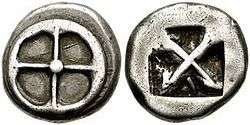 | |
| Obv: Four-spoked wheel | Rev: Incuse square, divided diagonally |
| Silver didrachm of Athens of heraldic type from the time of Peisistratos, 545–510 BC | |
| Obol of Athens, 545-525 BC | |
|---|---|
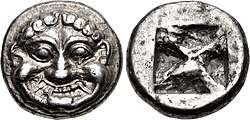 | |
| Obv: An archaic Gorgoneion | Rev: Square incuse |
| An archaic silver obol of Athens of heraldic type from the time of Peisistratos, 545–525 BC | |
As opposed to the modern definition of a tyrant, which is a single ruler, often violent and oppressive, Peisistratos' career was a model example of tyranny, a non-heritable position taken by purely personal ability, often in violation of tradition or constitutional norms. We see this in remarks by both Herodotus and Aristotle. Herodotus, in his Histories, wrote that Peisistratos, "not having disturbed the existing magistrates nor changed the ancient laws… administered the State under that constitution of things which was already established, ordering it fairly and well",[21] while Aristotle wrote that "his administration was temperate…and more like constitutional government than a tyranny".[22] Peisistratos often tried to distribute power and benefits rather than hoard them, with the intent of easing stress between the economic classes. The elites who had held power in the Areopagus Council were allowed to retain their archonships. For the lower classes, he cut taxes and created a band of travelling judges to provide justice for the citizens. Peisistratos enacted a popular program to beautify Athens and promote the arts. He minted coins with Athena's symbol (the owl), although this was only one type on the so-called Wappenmünzen (heraldic coins) and not a regular device as on the later, standard silver currency. Under his rule were introduced two new forms of poetry, the dithyramb and tragic drama, and the era also saw growth in theatre, arts, and sculpture. He commissioned the permanent copying and archiving of Homer's two epic poems, the Iliad and the Odyssey, and the canon of Homeric works is said to derive from this particular archiving. Much of Athens grandeur started with Peisistratos and his push for larger and more luxurious buildings.
Three attempts at tyranny
With Peisistratos' successful invasion and capture of Nisaea, he attained great political standing in the assembly. He initially met with resistance from nobles like Megacles, the son of Alcmaeon, and Lycurgus, the son of Aristolaïdes, who had shared power between them. Megacles came over to Peisistratos' side and, with his help, Peisistratos was accepted as tyrant by the Athenian assembly in 561, and, according to Herodotus, he "administered the state constitutionally and organized the state's affairs properly and well."[21] However, he was soon thereafter ousted. Herodotus explains his exile “Not much later, however, the supporters of Megacles and those of Lycurgus came to an understanding and expelled him”.
He soon had a second chance. Megacles invited him back in 556 on condition that he marry Megacles' daughter. Peisistratos returned in triumph accompanied by a tall, local woman named Phye, whom he passed off as Athena. The awestruck Athenians thus accepted his second tyranny. Peisistratus, however, refused to impregnate Megacles' daughter not wanting to dilute his families power, which ended their coalition. Peisistratos was forced to leave Attica entirely. During his nearly ten-year exile, he aligned himself with powerful individuals, and accumulated great wealth. With a strong personal army, he marched to Marathon and from there to Athens. His popularity soared and many locals supported him. Thus, in 546 BC, he began his third and final tyranny.[23] With this tyranny being one of the longest lasting tyrannies in classical Greece history.
Policies
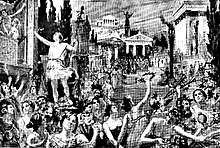
Peisistratos' main policies were aimed at strengthening the economy, and similar to Solon, he was concerned about both agriculture and commerce. He offered land and loans to the needy. He encouraged the cultivation of olives and the growth of Athenian trade, finding a way to the Black Sea and even Italy and France. Under Peisistratos, fine Attic pottery travelled to Ionia, Cyprus and Syria. In Athens, Peisistratos' public building projects provided jobs to people in need while simultaneously making the city a cultural centre. He replaced the private wells of the aristocrats with public fountain houses. Peisistratos also built the first aqueduct in Athens, opening a reliable water supply to sustain the large population.[24]
Legacy
Peisistratos died in 527 or 528 BC. His eldest son, Hippias, succeeded him as tyrant of Athens. Hippias and his brother, Hipparchus, ruled the city much as their father had. After a successful murder plot against Hipparchus conceived by Harmodius and Aristogeiton, Hippias became paranoid and oppressive. This change caused the people of Athens to hold Hippias in much lower regard. The Alcmaeonid family helped depose the tyranny by bribing the Delphic oracle to tell the Spartans to liberate Athens, which they did in 508 BC. The Peisistratids were not executed, but rather were mostly forced into exile. The surviving Peisistratid ruler, Hippias, went on to aid the Persians in their attack on Marathon (490 BC), acting as a guide.[25]
After the death of Peisistratus, Athens was much less important politically and with military status compared to Sparta. Nonetheless, the religious and patriotic unification of Athens had made great progress during Peisistratus’s ruling. As Aristotle reports, it became a common saying that the tyranny of Peisistratus had been the age of Cronus, the golden age. [26]
The poet Dante in Purgatorio XV of the Comedia uses Peisistratos as an example of meekness since he was well known for being able to placate wrath with a gentle answer.
According to Suda the bodyguards of Peisistratos were called wolf-feet (Λυκόποδες), because they always had their feet covered with wolf-skins, to prevent frostbite; alternatively because they had a wolf symbol on their shields.[27]
Notes
- Everdell, William R. (2000). The End of Kings: A History of Republics and Republicans. Chicago: University of Chicago Press. pp. 42. ISBN 978-0226224824.
- Shanaysha M. Furlow Sauls (2008). The Concept of Instability and the Theory of Democracy in the Federalist, p. 77
- Samons, Loren J. (2007). What's Wrong with Democracy?: From Athenian Practice to American Worship. University of California Press. p. 27. ISBN 9780520251687.
- Chester G. Starr, ENCYCLOPÆDIA BRITANNICA Peisistratus TYRANT OF ATHENS Archived 2016-07-01 at the Wayback Machine
- Sarah B. Pomeroy, Stanley M. Burstein, Walter Donlan, Jennifer Tolbert Roberts, David Tandy, Ancient Greece: a political, social, and cultural history(United States of America: 2012) Oxford University Press, New York, p191-2025
- Aristotle, The Athenian Constitution, Part 13
- Goušchin, Valerij (1999). "Pisistratus' Leadership in A. P. 13.4 and the Establishment of the Tyranny of 561/60 B. C.". The Classical Quarterly. New Series. 49 (Cambridge University Press): 14–23. doi:10.1093/cq/49.1.14. JSTOR 639486.
- Herodotus. The Histories. 1.59.4.
- Aristotle, The Athenian Constitution, Part 13; Herodotus, The Histories, 1.59; Plutarch, “Life of Solon”, in Plutarch’s Lives (London: Printed by W. M'Dowell for J. Davis, 1812), 185.
- Connor, W.R. (1987). "Tribes, Festivals and Precessions; Civic Ceremonial and Political Manipulation in Archaic Greece". Journal of Hellenic Studies. 107: 40–50. doi:10.2307/630068. JSTOR 630068.
- Aristotle, The Athenian Constitution, Part 14; Herodotus, The Histories, 1.60.
- Lavelle, B. M. (2010). Fame, Money and Power; The Rise of Peisistratos and Democratic Tyranny at Athens. Michigan. pp. 118–122.
- Cole, J. W. (1975). "Peisistratus on the Strymon". Greece & Rome. 22 (1): 42–44. doi:10.1017/S0017383500020052. ISSN 0017-3835. JSTOR 642830.
- Starr, Chester (April 2019). "Peisistratus: TYRANT OF ATHENS". Encyclopedia Britannica.
- Dimitriou, Elias (2018). The Rivers of Greece: Evolution, Current Status and Perspectives. Springer. ISBN 978-3-662-55369-5.
- Cartwright, Mark (August 2015). "Temple of Olympian Zeus, Athens". Ancient History Encyclopedia.
- Lintott, Andrew (2015). Violence, Civil Strife and Revolution in the Classical City 750-330 BC. New York: Croom Helm Ltd. p. 78. ISBN 9781138019751.
- Hopper, R.J. (1952). "History of the Athenian Constitution to the End of the Fifth Century B.C.". The Journal of Hellenic Studies. 76: 141–142. doi:10.2307/629610. JSTOR 629610.
- "Pisistratus". December 2019.
- Andrewes, Antony (1956). The Greek Tyrants. London: Hutchinson’s University Library. ISBN 0090295641.
- Herodotus. The Histories. 1.59.5b.
- Aristotle, The Athenian Constitution, Part 16.2.
- Lavelle, Brian (2010). "Pisistratos". Oxford Encyclopedia of Ancient Greece and Rome.
- Sarah B. Pomeroy, Stanley M. Burstein, Walter Donlan, Jennifer Tolbert Roberts, David Tandy, Ancient Greece: a political, social, and cultural history(United States of America: 2012) Oxford University Press, New York, p.191–2025
- Herodotus (1998). The Histories. Translated by Waterfield, Robin. Oxford: Oxford University Press. ISBN 9780192824257.
- Starr, Chester (April 2019). "Peisistratus: TYRANT OF ATHENS". Encyclopedia Britannica.
- Suda, la.812
References
| Wikisource has the text of the 1911 Encyclopædia Britannica article Peisistratus. |
- Berti, Monica. Fra tirannide e democrazia: Ipparco figlio di Carmo e il destino dei Pisistratidi ad Atene. Alessandria: Edizioni Dell’Orso, 2004
- Borthwick, Edward K. “Music and Dance.” Civilization of the Ancient Mediterranean World: Greece and Rome. Eds. Grant, Michael and Kitzinger, Rachel. 3 vols. New York: Scribner's, 1988. Vol. 1, 1507-8.
- Cahill, Thomas. Sailing the Wine Dark Sea: Why the Greeks Matter. New York: Doubleday, 2003.
- William Everdell, The End of Kings: A History of Republics and Republicans. Chicago: University of Chicago Press, 2000.
- French, A. “The Party of Peisistratos.” Greece & Rome. Vol. 6, No. 1, March 1959. 45-57
- Garland, Robert. “Greek Spectacles and Festivals.” Civilization of the Ancient Mediterranean World: Greece and Rome. Eds. Grant, Michael and Kitzinger, Rachel. 3 vols. New York: Scribner's, 1988. Vol. 1, 1148.
- Hornblower, Simon and Spawforth, Anthony eds. “Peisistratus.” The Oxford Classical Dictionary. 3rd ed. Oxford University Press, 2003.
- Lavelle, B. M. Fame, Money and Power: The Rise of Peisistratos and “Democratic” Tyranny at Athens. The University of Michigan Press, 2005.
- Lavelle B. M. “The Compleat Angler: Observations on the Rise of Peisistratos in Herodotos (1.59-64). The Classical Quarterly. New Series, Vol. 41, No. 2, 1991. 317-324.
- Thucydides. “Funeral Oration of Pericles.” The Peloponnesian War. Trans. Benjamin Jowett, 1881. Ed. Paul Brians. December 18, 1998. <http://katie.luther.edu/moodle/mod/resource/view.php?id=68564>
- Roisman, Joseph, and translated by J.C Yardley, Ancient Greece from Homer to Alexander (Blackwell Publishing Ltd, 2011) ISBN 1-4051-2776-7
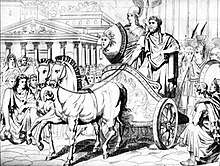
_Pentathlon.svg.png)